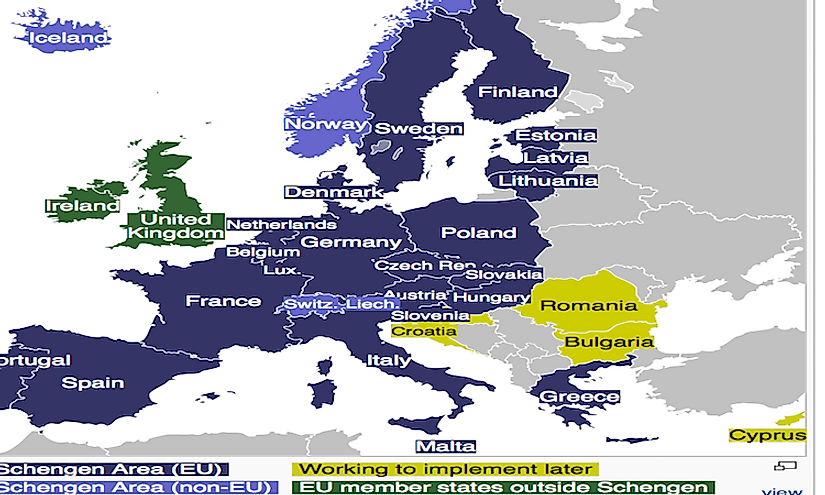Schengen Countries

Schengen Countries comprise of 26 European nations that have abolished any border control at their borders. The Schengen area was established to allow free movement of people between signatory states. Schengen Countries maintain open borders between themselves and tighter border control with non-Schengen nations.
The Schengen Countries Of The World
The 26 European Countries which form the Schengen Countries are Germany, France, Italy, Spain, Poland, Netherlands, Belgium, Greece, Portugal, Czech Republic, Hungary, Austria, Switzerland, Denmark, Slovakia, Finland, Norway, Lithuania, Latvia, Slovenia, Estonia, Luxembourg, Malta, Iceland, and Liechtenstein.
History Of The Schengen Countries
Before the Schengen Cooperation, the Saarbrücken agreement was signed in 1984 between France and Germany, which allowed for the gradual abolition of checks and free movement of people and goods between their mutual borders. The Schengen agreement was subsequently signed in 1985 between France, Germany and the Benelux countries, namely Netherlands, Belgium, and Luxembourg. The name Schengen refers to the town of Schengen in Luxembourg where the agreement was signed. The objective of the accord was to abolish customs checks at the mutual borders in line with establishing adequate controls in their external borders.
In 1990, the signatories affirmed their intentions at the abolition of checks at internal borders by signing the Schengen Implementing Convention. On the foundation of a mutual visa policy, the Schengen Area was established on March 26, 1995. From then, border crossing points were removed between member countries. Other European countries joined the cooperation, and it was incorporated into the European Union framework through the Amsterdam Treaty of 1999.
Schengen Membership
The integration of Schengen with the European Union was a major milestone for the organization. As it stands, all European Union nations without an opt-out are legally obliged by the EU law to join Schengen, after fulfilling the technical requirements. A country in the European Union wishing to join Schengen must exhibit a high capacity to efficiently regulate its borders. Such a country must also implement the information and data exchange systems needed to actively participate in Schengen. European Countries not currently in Schengen are the UK and Ireland by way of opt-out and Romania, Bulgaria, Cyprus, and Croatia, which are yet to fulfill the technical requirements.
Regulation Of Internal Borders
The internal borders are regulated through the Schengen Information System (SIS), which allows real-time communication between Schengen Countries. There is also excellent police coordination between Schengen countries to monitor the movement of people and goods. Most airports in the Schengen area have different terminals for Schengen citizens and non-Schengen citizens for easier regulation.
Rules And Regulation Of Travel Between Schengen Countries
Residents of the Schengen Area travel visa-free between member states. Most Citizens of non-Schengen Countries, however, require a Schengen visa to travel freely between countries. The Schengen countries formulate a list of countries, whose nationals are required to obtain a visa to travel within the area. Depending on the type of the permit given, travelers with a Schengen visa from one country can use the permit in another Schengen country for a period not exceeding 90 days. Schengen Countries are allowed to re-establish internal border checks if national security calls for such an action.
Schengen Countries
| Rank | State | (km²) | Population |
|---|---|---|---|
| 1 | Germany | 357,050 | 81,799,600 |
| 2 | France | 551,695 | 63,929,000 |
| 3 | Italy | 301,318 | 60,681,514 |
| 4 | Spain | 510,000 | 46,030,109 |
| 5 | Poland | 312,683 | 38,186,860 |
| 6 | Netherlands | 41,526 | 16,703,700 |
| 7 | Belgium | 30,528 | 11,007,020 |
| 8 | Greece | 131,990 | 10,815,197 |
| 9 | Portugal | 92,391 | 10,647,763 |
| 10 | Czech Republic | 78,866 | 10,535,811 |
| 11 | Hungary | 93,030 | 9,979,000 |
| 12 | Sweden | 449,964 | 9,415,570 |
| 13 | Austria | 83,871 | 8,414,638 |
| 14 | Switzerland | 41,285 | 7,866,500 |
| 15 | Denmark | 43,094 | 5,564,219 |
| 16 | Slovakia | 49,037 | 5,440,078 |
| 17 | Finland | 338,145 | 5,391,700 |
| 18 | Norway | 385,155 | 5,063,709 |
| 19 | Lithuania | 65,300 | 3,207,060 |
| 20 | Latvia | 64,589 | 2,245,357 |
| 21 | Slovenia | 20,273 | 2,048,951 |
| 22 | Estonia | 45,338 | 1,340,194 |
| 23 | Luxembourg | 2,586 | 511,840 |
| 24 | Malta | 316 | 417,608 |
| 25 | Iceland | 103,000 | 318,452 |
| 26 | Liechtenstein | 160 | 36,010 |







